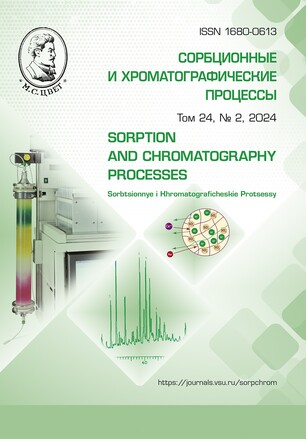Diffusion and chemical kinetics of methylene blue dye adsorption on silica doped with iron (III) ions
Abstract
Silica are widely used in catalysis, adsorption, and chromatography. In the last decade, they have been increasingly used in medicine, however, to ensure their biocompatibility, silica need to be modified and the simplest way of such a modification is doping them with iron cations. The article presents a study of the sorption characteristics of silica doped with iron cations. The purpose of the study was to assess the effect of doping silica with iron ions on the kinetics of their adsorption of model sorbate of methylene blue dye. Doped silica were synthesised by the alkoxide sol-gel method at pH=1.5 and pH=5.0 with the introduction of iron cations into the reaction mixture during the hydrolysis of tetraethoxysilane. The iron content in the samples was 1.5, 2.3, and 3.8 at. %. According to the results of X-ray phase analysis, all samples were X-ray amorphous. According to the shape of the isotherms of low-temperature nitrogen adsorption, all samples were classified as microporous. The specific surface area of the samples and the total pore volume decreased slightly with an increase in the iron content in the samples. The adsorption of methylene blue dye was carried out at temperatures of 25, 30, and 35 °C. The kinetic adsorption curves were analysed using the following diffusion kinetics models: Boyd model (external diffusion process) and Weber-Morris model (internal diffusion process). Also, the kinetic data were analysed using kinetic models of pseudo first-order (Lagergren model) and pseudo second-order (Ho and McKay's model). It was established that all samples were characterised by a mixed-diffusion regime of the sorption process. Adsorption kinetics was adequately described by the model of pseudo-second-order.
Downloads
References
Kaur M., Sharma S., Bedi P.M., Silica supported Brönsted acids as catalyst in or-ganic transformations: A comprehensive review, Chinese Journal of Catalysis, 2015; 36(37): 520-549. https://doi.org/10.1016/S1872-2067(14)60299-0
Preeti S.S., Pradnya S.S., Kanchan K.P., Vedika M.B., Sandeep A.S., Sagar D.D., Sushilkumar A.J., A Brief Overview of Recent Progress in Porous Silica as Cata-lyst Supports, Journal of Composites Sci-ence, 2021; 5(3): 75. https://doi.org/10.3390/jcs5030075
Sudam K.P., Sukalyan D., Sabita P., Mishra B.K., Adsorption of organic mole-cules on silica surface, Advances in Colloid and Interface Science, 2006; 121: 13. https://doi.org/10.1016/j.cis.2006.05.028
Syeda S.F., Azry B., Muhammad A., Noraini A.G., Development and progress of functionalized silica-based adsorbents for CO2 capture, Journal of Molecular Liquids, 2021; 338: 116913. https://doi.org/10.1016/j.molliq.2021.116913
Engelhardt H., Löw H., Götzinger W., Chromatographic characterization of silica-based reversed phases, Journal of Chroma-tography A, 1991; 544: 371-379. https://doi.org/10.1016/S0021-9673(01)83996-0
Yashin Y.I., Yashin A.Y., Sorbents for HPLC. Current state and new directions of development (review), Sorption and chro-matographic processes, 2021; 21(2): 235-245. https://doi.org/10.17308/sorpchrom.2021.21/3357
Lok P.S., Sriman K.B., Rahul K., Geetika M., Usha S., Garima S., Saurabh A., Sol-Gel processing of silica nanoparti-cles and their applications, Advances in Colloid and Interface Science, 2014; 214: 17-37. https://doi.org/10.1016/j.cis.2014.10.007
Pajonk G.M. Some applications of sil-ica aerogels // Colloid and Polymer Sci-ence, 2003; 281: 637-651. https://doi.org/10.1007/s00396-002-0814-9
Xinbin Y., Christopher T.W., Recent advances in the applications of mesoporous silica in heterogeneous catalysis, Catalysis Science & Technology, 2002; 19: 5777-5788. https://doi.org/10.1039/D2CY00001F
Khludneva A.S., Karpov S.I., Influ-ence of the composition of the reaction medium on the structure and sorption prop-erties of mesoporous silica, Sorbtsionnye i khromatograficheskie protsessy, 2022; 22(4): 421-432. https://doi.org/10.17308/sorpchrom.2022.22/10571 (In Russ.)
Hench L.L., West J.K., The Sol–Gel Process, Chemical Reviews, 1990; 90: 33-72. https://doi.org/10.1021/cr00099a003
Gonçalves M.C., Sol-Gel Silica Na-noparticles in Medicine: A Natural Choice. Design, Synthesis and Products, Molecules, 2018; 23(8): 22-26. https://doi.org/10.3390/molecules23082021
Pohaku Mitchell K.K., Liberman A., Kummel A.C., Trogler W.C., Iron (III)-Doped, Silica Nanoshells: A Biodegradable Form of Silica, Journal of the American Chemical Society, 2012; 134(34): 13997-14003. https://doi.org/10.1021/ja3036114
Decyk P., Trejda M., Ziolek M., Kujawa J., Głaszczka K., Bettahar M., Monteverdi, S.M., Mercy Physicochemical and catalytic properties of iron-doped sili-ca—the effect of preparation and pretreat-ment methods, Journal of Catalysis, 2003; 219(1): 146-155. https://doi.org/10.1016/S0021-9517(03)00186-6
Nayanova E.V., Elipasheva E.V., Sergeev G.M., Sergeeva V.P. Redox prop-erties of methylene blue as a promising photometric reagent for determination of halogen oxidants. Analitika i kontrol’ [Analytics and Control], 2015; 19(2): 154-160. http://dx.doi.org/10.15826/analitika.2015.19.2.005 (In Russ.)
Boyd G.E., Adamson A.V., Myers L.S. Chromatographic method of ion sepa-ration. Moscow, Chemistry Publ., 1949, pt. 1, 333 p.
Weber W. J., Morris J. C., Kinetics of Adsorption on Carbon from Solution, Journal of the Sanitary Engineering Divi-sion, 1963; 89(2): 31-60. https://doi.org/10.1061/JSEDAI.0000430
Lagergren, S., About the theory of so-called adsorption of soluble substance, Svenska Vetenskapsakademiens Handlin-gar, 1898; 24: 1-39.
Ho Y.S., McKay G., Pseudo-second order model for sorption processes, Process Biochemistry, 1999; 34(5): 451-465. https://doi.org/10.1016/S0032-9592(98)00112-5







